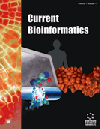- Home
- A-Z Publications
- Current Bioinformatics
- Previous Issues
- Volume 10, Issue 2, 2015
Current Bioinformatics - Volume 10, Issue 2, 2015
Volume 10, Issue 2, 2015
-
-
Investigating Power and Limitations of Ensemble Motif Finders Using Metapredictor CE3
More LessAuthors: Mauro Leoncini, Manuela Montagnero and Karina Panucia TillánEnsemble methods represent a relatively new approach to motif discovery that combines the results returned by "third-party" finders with the aim of achieving a better accuracy than that obtained by the single tools. Besides the choice of the external finders, another crucial element for the success of an ensemble method is the particular strategy adopted to combine the finders' results, a.k.a. learning function. Results appea Read More
-
-
-
Protein Sequence Annotation by Means of Community Detection
More LessAuthors: Giuseppe Profiti, Damiano Piovesan, Pier Luigi Martelli, Piero Fariselli and Rita CasadioIn the postgenomic era different electronic procedures are available for protein sequence annotation, the process of enriching, with structural and functional features, any protein after electronic translation from its correspondent gene or mRNA. The demand of reliable annotation systems is particularly urgent given the volume of genomic data that are daily produced by next generation sequencing machines. In this paper we Read More
-
-
-
Discretization of Expression Quantitative Trait Loci in Association Analysis Between Genotypes and Expression Data§
More LessExpression quantitative trait loci are used as a tool to identify genetic causes of natural variation in gene expression. Only in a few cases the expression of a gene is controlled by a variant on a single genetic marker. There is a plethora of different complexity levels of interaction effects within markers, within genes and between marker and genes. This complexity challenges biostatisticians and bioinformatitians every day Read More
-
-
-
Lexical Characterisation of Bio-Ontologies by the Inspection of Regularities in Labels
More LessHundreds of biomedical ontologies have been produced, with many of the significant, widely used ones being developed in collaborative efforts and following a set of construction principles, which include using a systematic naming convention for their labels. Despite their success, many of these ontologies have lacked a foundation of axioms that would expose the wealth of knowledge in the ontologies to computational reasoning. Read More
-
-
-
Incremental Construction of Biological Networks by Relation Extraction from Literature
More LessAuthors: Dragana Miljkovic, Vid Podpečan, Tjasa Stare, Igor Mozetic, Kristina Gruden and Nada LavračThis work focuses on automated incremental development of biological networks. The Bio3graph approach to information extraction from biological literature is extended with new features which allow for periodical updates of network structures using newly published scientific literature. The incremental approach is demonstrated on two use cases. First, a simple plant defence network with 37 components and Read More
-
-
-
Efficient and Error-Tolerant Sequencing Read Mapping
More LessAuthors: Piotr Jaroszyński and Norbert DojerMost efficient read mappers build a Ferragina-Manzini index of a genome sequence and then process reads against it. In order to handle differences between reads and corresponding genome fragments, approximate read occurrences are searched in the index. This technique is particularly efficient for mapping reads of length ∼30bp with up to 2-3 errors, as first massive sequencers required. However, within the Read More
-
-
-
A Hierarchical Classification for the Selection of the Most Suitable Multiple Sequence Alignment Methodology
More LessAuthors: Francisco M. Ortuño, Hector Pomares, Olga Valenzuela, Carolina Torres and Ignacio RojasMultiple sequence alignments (MSAs) are currently one of the most powerful procedure in bioinformatics in order to provide additional information useful to other understanding techniques such as biological function analyses, structure predictions or next-generation sequencing. Nevertheless, current MSA methodologies are providing quite different alignments for the same set of sequences depending on some particular biolog Read More
-
-
-
Regulation of Meiosis Initiation before the Commitment Point in Budding Yeast: A Review of Biology, Molecular Mechanisms and Related Mathematical Models
More LessAuthors: Clampi T. Wannige, Don Kulasiri and Sandhya SamarasingheWe present a review of the initiation of meiosis in budding yeast, Saccharomyces cerevisiae, specially focusing on the initiation stage before the commitment point. We discuss the molecular mechanisms involved in tight regulation of the initiation process using experimental facts and present a comprehensive discussion of the advantages and limitations of the available mathematical models on the meiosis initiation of budding Read More
-
-
-
Effect of Hubs in Amino Acid Network on Iron Superoxide Dismutase Stability
More LessAuthors: Yanrui Ding, Xueqin Wang and Zhaolin MouBased on structural information of iron superoxide dismutase (Fe-SOD), we constructed various types of Fe-SOD amino acid networks (Fe-SOD AANs). Analyses of the degree of distribution and "rich clubs" of these Fe-SOD AANs indicated that Fe-SOD AANs have highly interacting nodes, namely, the hubs. Interestingly, most hubs are hydrophobic amino acids including Ile, Leu, Phe, Ala and Val. These residues form a stron Read More
-
Volumes & issues
-
Volume 20 (2025)
-
Volume 19 (2024)
-
Volume 18 (2023)
-
Volume 17 (2022)
-
Volume 16 (2021)
-
Volume 15 (2020)
-
Volume 14 (2019)
-
Volume 13 (2018)
-
Volume 12 (2017)
-
Volume 11 (2016)
-
Volume 10 (2015)
-
Volume 9 (2014)
-
Volume 8 (2013)
-
Volume 7 (2012)
-
Volume 6 (2011)
-
Volume 5 (2010)
-
Volume 4 (2009)
-
Volume 3 (2008)
-
Volume 2 (2007)
-
Volume 1 (2006)
Most Read This Month
Article
content/journals/cbio
Journal
10
5
false
en


